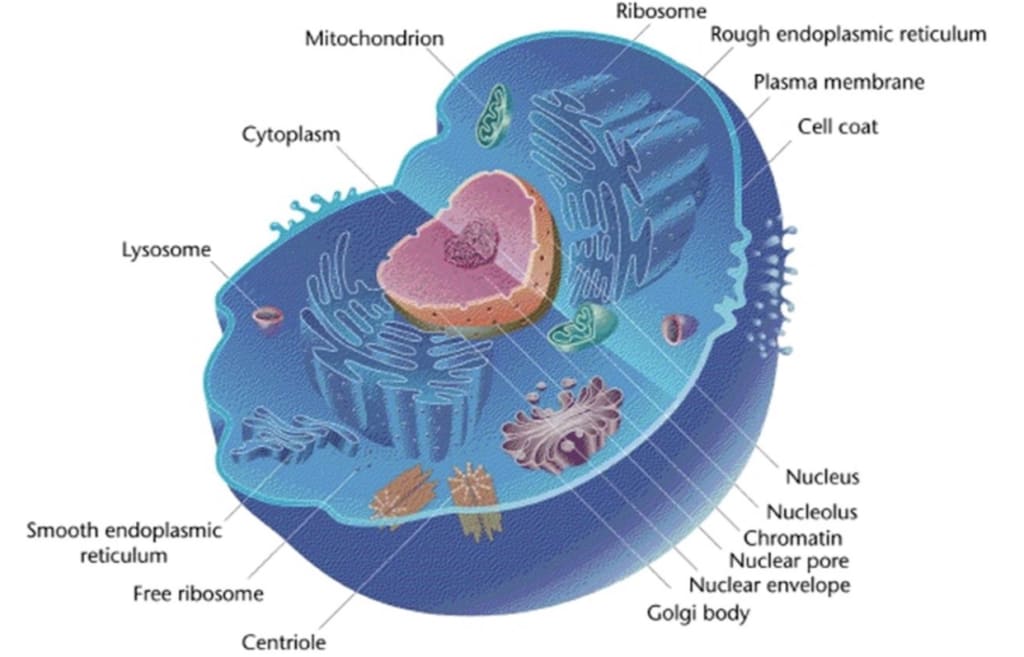
Protein is required for an animal cell to perform activities necessary for its survival. Though protein is made by the ribosome (an organelle), many other organelles (specialized cell parts that performs a specific function) within the cell contributes to its production and delivery. Therefore, for a cell to be able to survive, all organelles within the cell must be able to properly function. It is important to have a proper understanding of these organelles before it is possible to understand how protein is produced. Parts of a cell that contribute to protein production includes the nucleus (containing nucleolus and DNA and is surrounded by a nuclear membrane), ribosomes, the endoplasmic reticulum, vesicles, the Golgi body, and the cell membrane. The definitions and functions of these parts will be specifically discussed in the paragraph(s) below.
The nucleus is and organelle that controls all the activities in a cell. The nuclear membrane surround the nucleus to protect its contents. Located on the nuclear membrane are nuclear pores, functioning as openings that allows only certain materials to pass into or out of the nucleus. Within the nucleus is nucleolus; and organelle specialized in making ribosomes (which will be later explained).
The nucleus also contains molecules that look like a twisted ladder, called DNA (deoxyribonucleic acid). This molecule has sides that scientists refer to as “double helix” made of sugar and phosphate, while the bases are made of nitrogen. These bases are represented by the letters A (adenine), T (thymine), G (guanine), and C (cytosine). A is always joined with T, while G is always joined with C. The order and number of these bases may greatly vary; a single strand of DNA in a human can be millions of base pairs long, and affecting the occurrences within the cell. This molecule exists in the form of chromatin (which also contains proteins).
The chromatin is referred to as chromosome when it is coiled and compacted into a X-shaped structure. In humans, most cells have 46 chromosomes (23 pairs). On the chromosome are small segments of DNA, called genes, which contain information to produce 90,000 to 100,000 different types of proteins, however, only certain genes are used in each cell to create a specific protein. Creating specific proteins allows a cell to become specialized in performing a certain function; these specialized cells form tissues, and these tissues form organs.
As previously mentioned, ribosomes are created by the nucleolus. These organelles either float in cytoplasm or is attached to the endoplasmic reticulum, and creates the required proteins needed in a cell. The cytoplasm is a jelly-like substance, and contains all the organelles and other materials, such as sugar and water. The endoplasmic reticulum acts as a network of channels within the cell, and transports materials made in the cell. The Golgi body sorts and packages proteins for transport. For both the endoplasmic reticulum and the Golgi body, vesicles will form off the end and act as sacs for protein transportation. The mitochondria performs cellular respiration by changing glucose and oxygen into water, carbon dioxide and energy. A cell membrane surrounds the cell to separate the contents of a cell from its exterior. Some animal cells have small vacuoles acting as storage containers.
The organelles mentioned above are all parts in an animal cell. Certain parts (including the large vacuole, the cell wall and chloroplast) are not mentioned for the reason that they are only in plant cells and are not necessary to contribute to the understanding of protein production in animal cells. The paragraph below explains the steps to protein production in an animal cell.
The nucleus first receives a chemical signal to make a specific protein. This message is contained in the DNA (deoxyribonucleic acid), which is copied into RNA (ribonucleic acid). (This is done because RNA is smaller than DNA, which would allow it to leave through the nuclear pores.) The RNA then leaves through a nuclear pore, and arrives at the ribosome. The ribosome creates the protein; this protein goes through the endoplasmic reticulum. A vesicle forms off the endoplasmic reticulum, carrying the protein to the Golgi body. The Golgi body repackages the protein, and a vesicle carrying the protein forms off. This vesicle then carries the protein to the cell membrane; the vesicle attaches to the cell membrane, and its proteins are released out of the cell.
The nucleus of a cell controls all the activities of the organelles in that cell. Chromosomes in the nucleus are made of DNA; a molecule that carries genes, which contains the information to produce proteins. All organelles within an animal cell has a part in protein production. For a cell to properly function, all parts of the cell must be able to work together to produce and deliver the protein.
(All information above was from textbook BC Science 9 or learned from my science teacher.)






Comments
There are no comments for this story
Be the first to respond and start the conversation.